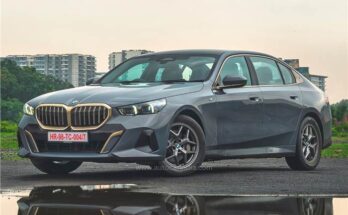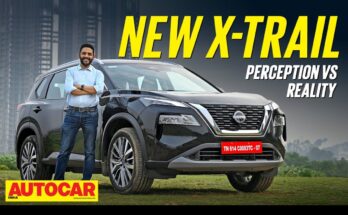The Audi e-tron facelift arrives with a new style, new tech and a new nameplate too, placing it atop Audi’s electric SUV hierarchy.
When Audi launched their first EV, they called it the e-tron. Simple and catchy, but with ‘e-tron’ now the company’s electric sub-brand – e-tron GT, Q4 e-tron – the original e-tron needed its own identity. Enter Q8 e-tron. With its new name, the facelifted e-tron now has an established position, at the top of Audi’s electric SUV portfolio.
Beyond the new name, there’s a fair bit new with the facelift too. For starters, and key to an EV today, the range has been massively improved, it’s also nicer to drive and, of course, there’s a new look.
Audi Q8 e-tron: exterior style
The original e-tron styling was pretty straightforward and ‘conventional’, and the Q8 e-tron is also similar in that sense and avoids any radical design language that screams electric, but it’s certainly more attractive to look at, at least to these eyes. At the front, there are many cuts and creases around, the grille gets multiple individual openings and the outer ends of the bumper have massively flared recesses, with a multi-faceted surface. Audi has managed it all very well, making the car look striking and sporty.The headlights retain the Audi signature light design, but the top edge of the grille now has a recessed LED light bar that looks really neat, casting a glow onto the grille and logo below. Speaking of which, the logo is now the new two-dimensional corporate logo that will appear across the Audi range.

Like before, the Q8 will be available as an SUV and as a Sportback. Also, notice the glow from the LED light bar.
The sides remain familiar and there are multiple alloy wheel patterns to be had, so it remains to be seen what will arrive in India. The rear-view camera stalks are also prominently seen, but for India, we’ll get regular mirrors, which is good. More on that later.

Changes to the rear are minimal, unlike the front end.
As before, there are two body styles, the SUV and Sportback. The Sportback has a sharply raked tailgate and windscreen with a lip spoiler on the boot lid, whereas the SUV has an integrated spoiler atop the windscreen. That distinction aside, there’s a lot in common between the two. Like the pre-facelift, both carry an LED light bar that stretches across the body width and both cars have the same bumper and diffuser treatment. Along with the aesthetic changes, Audi has also reduced the drag coefficient from 0.26 to 0.24 for the Q8 Sportback e-tron and from 0.28 to 0.27 for the Q8 e-tron.
Audi Q8 e-tron: interior and features
Step inside and it’s an ‘Audi’ immediately. Component-wise, not much has changed and the only changes are to the trim bits and colours, which is great. The interior smacks of quality, it is very well-built and feels good to the touch.
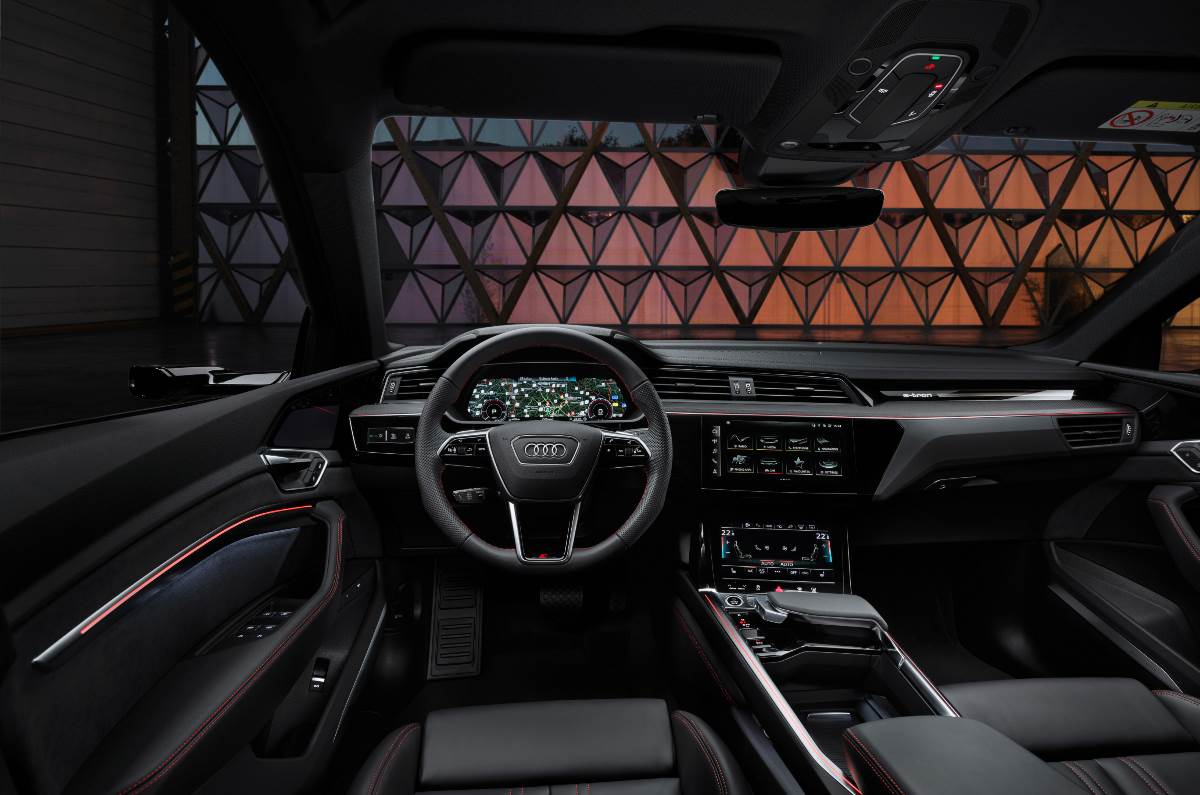
Screens give the cabin a techy feel but there’s an over-reliance on them.
There’s also a very techy feel to it with screens all around but there’s an overreliance on them. The HVAC screen does have haptic feedback, but you still have to take your eyes off the road to look at it. And then the outside rear-view mirrors give way to camera-fed screens. It has its advantages – in certain light and weather conditions you get a clearer view but for most parts, mirrors are simply better. For instance, you can simply tilt your head forward when you need a deeper look, like when waiting to join from the side of the road. Here, you have to tap the screen and then slide your finger about to pan the camera.
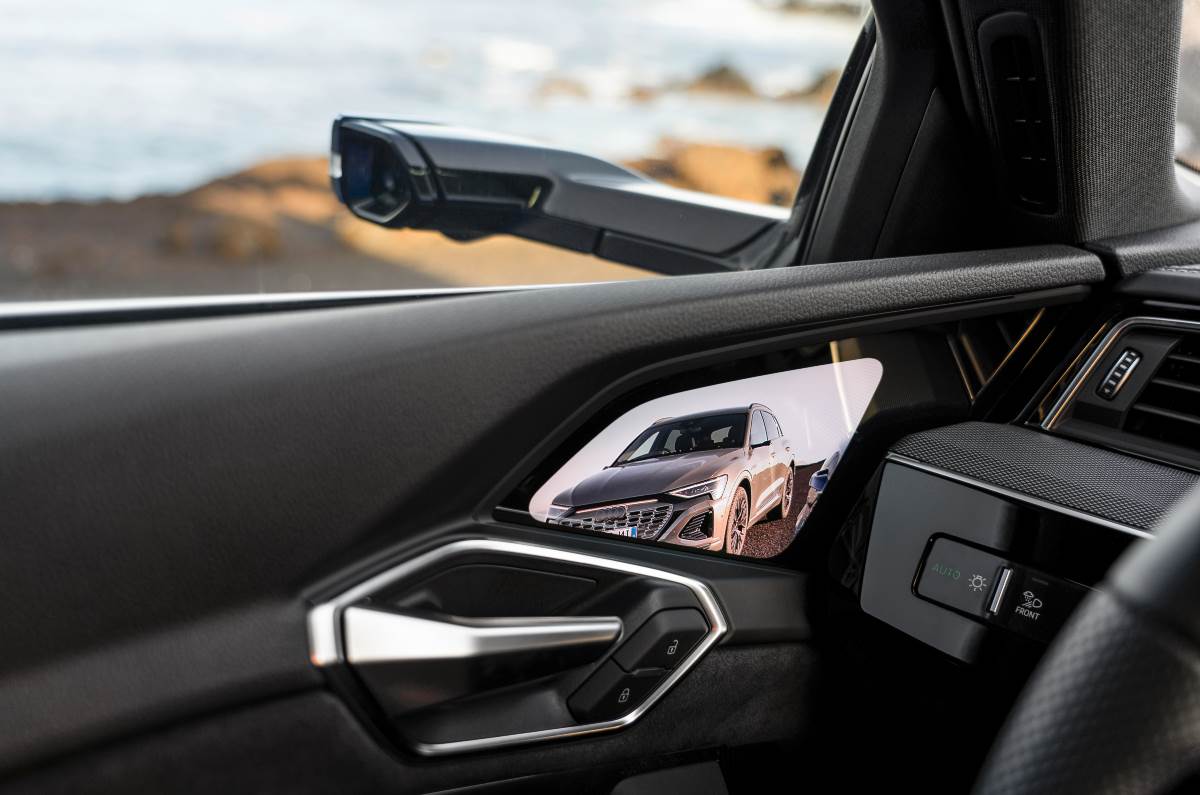
Instead of the rear-view cameras, we will get regular mirrors which are more practical on the move.
A muddy splash onto the small lens area can also completely block your vision, and on a more personal note, I often use the mirrors for two-way eye contact with the driver behind me to work out merging at jammed toll plazas; here, it isn’t possible. India will get rear-view mirrors though and it’s really for the best.

Insides are built to typically high Audi standards. Legroom and headroom are both good at the back.
The e-tron impressed us with its practical interior and the Q8 is no different. Being built on the same MLB platform as the earlier car, the Q8’s insides are similar, so you have a near-flat floor, and despite the battery below, it avoids the knees-up position you end up with in some EVs. There’s sufficient space all around and the seats are nice and comfortable. Space at the rear is also good and while the headroom in the Sportback is lower, it was still sufficient for my 5ft 8in frame. Boot space is also large, with 528 litres for the Sportback and 569 for the SUV, plus there’s a 62-litre front storage trunk or ‘frunk’.
Audi Q8 e-tron: battery and driving range
The biggest update to the new car is an increase in the driving range and that’s been effected in two ways, an improved battery management system and an introduction of larger battery sizes. Thus, the earlier 50 variants’ 71kWh battery is no more and instead, the new 50 version cars now come with the erstwhile 55 trim’s 95kWh battery. With the larger size and system improvements, the driving range is now up from 300km and 347km for the SUV and Sportback to 491km and 505km, respectively. The new 55 version cars get a larger 114kWh pack, which sees the range go up from 411km and 446km for the SUV and Sportback to 582km and 600km, respectively. Naturally, charging times vary with battery size and charging speed, but on an 11kw AC charger, the 55 takes 11 and a half hours to fully charge, while on a 150kw DC charger, 10 percent to 80 percent takes only 30 mins.
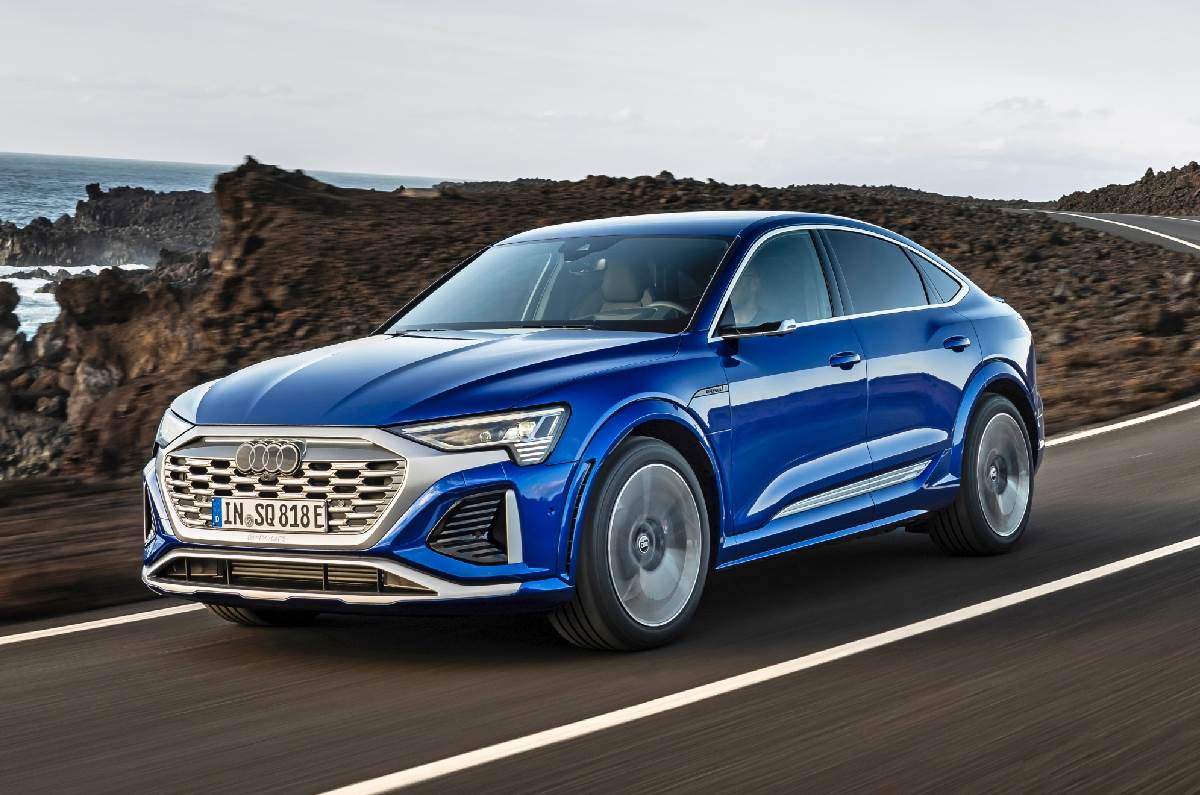
The Audi SQ8 has more power and tidier handling, but it won’t come to India.
There is also a higher performance three motor version called the SQ8 – earlier e-tron S – which uses the same battery pack as the 55 cars, but on account of the increased power output see a lower 494km and 513km range for the SUV and Sportback, respectively. This brings us to the driving bit and some bad news.
Audi Q8 e-tron: performance and handling
Bad news first, India will not get the SQ8 version. Yes, that’s that, but the good news is that we will see 50 and 55 trim cars in both SUV and Sportback body styles, and after driving the 55 variant on the beautiful Canary Island of Lanzarote, I can say it’s very entertaining and pleasurable to drive.
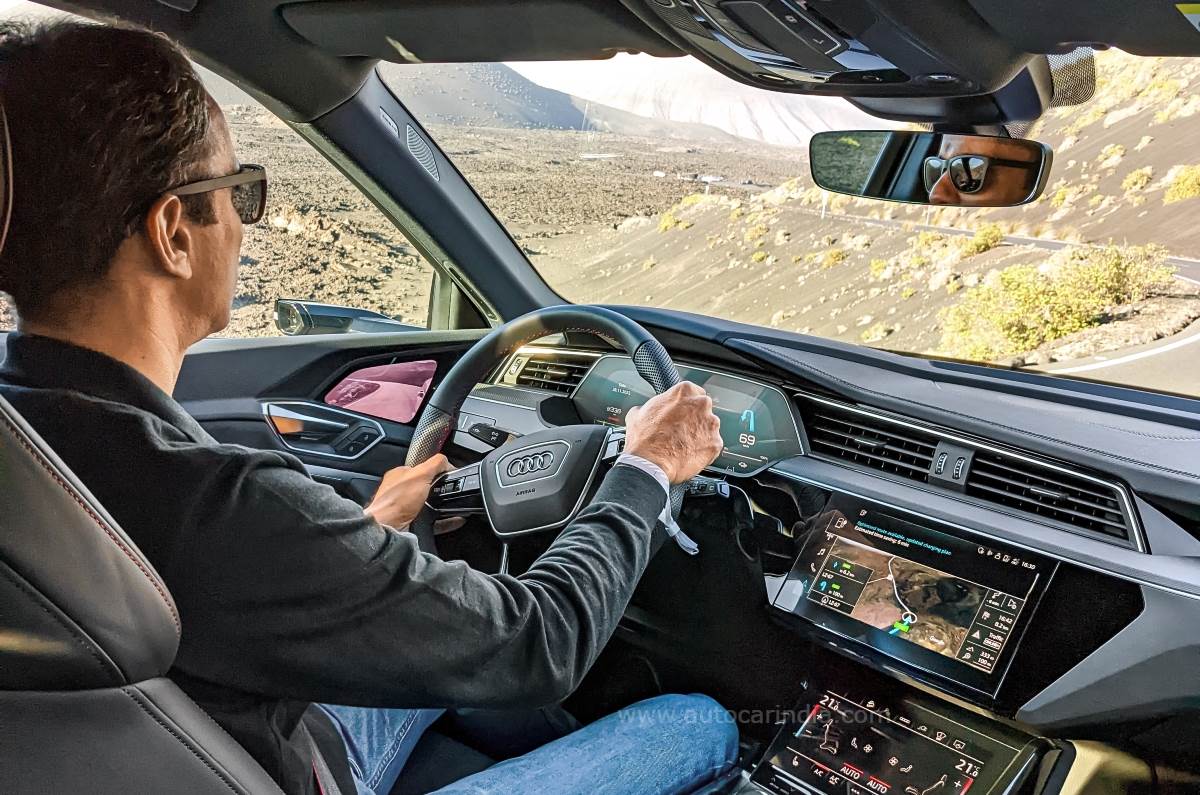
Steering is noticeably improved, and as before, the handling is nice and predictable.
Having spent a lot of time with our long-term e-tron, its driving characteristic is very well imprinted on me, and the first thing I noticed with the Q8 is how the steering feels better compared to the earlier car’s slightly inert feel. Audi says they have made a 10 percent improvement in steering responsiveness, which is basically how quickly the rear axle follows the front in a turn. There’s also a 10 percent reduction in the amount of steering input needed to effect a turn and a 20 percent improvement in the overall weight and feedback. And while 10 and 20 percent may not sound like much, driving through some sweeping corners on the island it’s noticeably improved over the original car.
Handling is nice and predictable, and the Q8 actually feels quite nimble from behind the wheel. There are also the drive modes that alter steering weight, and in its lightest ‘Comfort’ setting, it’s quite easy and handy in town. These modes also control ride height and damper firmness, and given that Lanzarote had no potholes, or even cracks for that matter, we’ll reserve the judgment on the ride for when we drive the car in India. Thanks to the air springs, ride height can be varied by 76mm, so that will prove handy here.
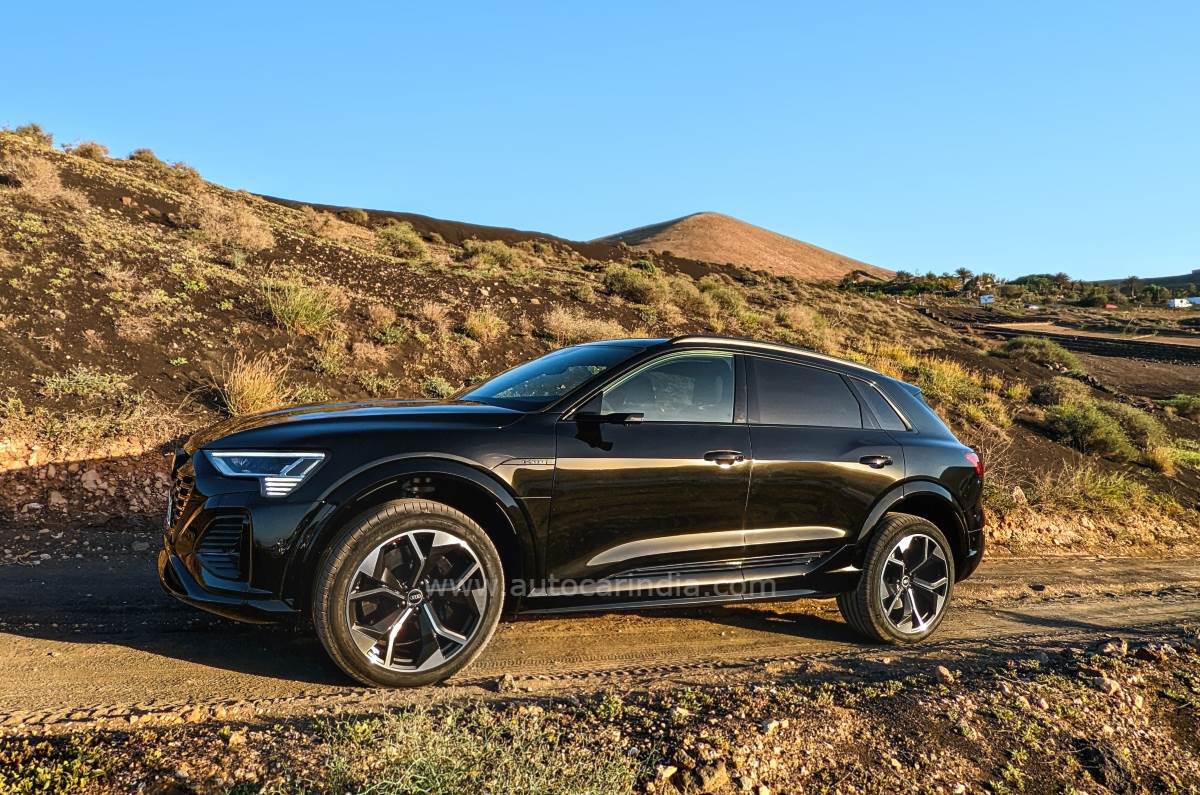
Thanks to air springs, ride height can vary by 76mm.
Both 50 and 55 versions use a dual-motor set-up, which makes a combined 340hp on the 50, while in the 55, you get 408hp; torque is the same in both, at 664Nm. As you’d expect from electrics today, power delivery is immediate, strong and very linear. So overtaking isn’t a challenge, and as far as thrills go, it’s very entertaining putting your foot down and enjoying that instant slug of torque. The 55 has a claimed 0 to 100kph time of 5.6sec, which is plenty quick even if you don’t factor in the 2,500kg unladed weight. The 50 – which we didn’t get to drive – does it in a claimed 6sec. The SQ8 clocks 4.5sec, thanks to its three-motor setup that outputs 503hp and 973Nm of torque. And as I mentioned earlier, we did drive it briefly. And suffice to say, acceleration is entertaining and it is clearly set up for thrills with even a broader track and a firmer suspension that give it better road holding. Given the smooth roads, it’s hard to say how this impacts the ride, but there is an underlying firmness to its feel.
Audi Q8 e-tron: price and verdict
So when will we see the Q8 e-tron in India? July-August 2023 is the likely launch period, and you can expect it at a slight premium over the current e-tron. So, a starting price of Rs 1.3 crore (ex-showroom) for the 50 trim is a fair bit of money. But what works for the Q8 e-tron is that the original car was already a compelling buy. It was the winner in our group comparison and its practical and comfortable interiors remain with the Q8. Plus, now, it’s smarter to look at, drives better and offers a much longer range too. So, as things stand, the new Q8 e-tron is stacked up really very well indeed.
Also see:
Source link

